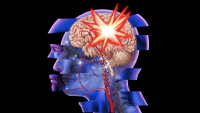Learn about the connection between this rare condition and a common childhood illness.
Takeaways:
- Pediatric autoimmune neuropsychiatric disorders associated with streptococcal infections (PANDAS) is thought to be an autoimmune disease presents with the sudden onset of obsessive compulsive behaviors in children.
- Nurses can play an important role in educating children and families about the disorder and helping them navigate the healthcare system as they seek care.
Strep throat snapshotStrep throat is caused by Streptococcus pyogenes, a group A beta-hemolytic streptococcal (GABHS) bacterium. It affects children and adults but is more common in children age 5 to 15 years old. Approximately 25% of sore throats in children (10% in adults) are attributed to GABHS. Symptoms
Diagnosis
Treatment
Complications
|
What is PANDAS?
What are the symptoms?
What are the risk factors?
How is it diagnosed?
- OCD and/or a tic disorder
- Abrupt onset of OCD
- Neurologic abnormalities
- Association with GABHS infection
- Prepuberal onset
PANDAS is rare, so sometimes the provider doesn’t make the connection between a GABHS infection and the onset of OCD symptoms. In many cases, the symptoms of GABHS have resolved or are simply overlooked because of concern about the more dramatic neurologic/behavioral changes.
With any sudden onset of OCD and other neurologic behaviors, a rapid antigen test and/or throat culture should be ordered to determine if the patient has an active GABHS infection. If no acute GABHS symptoms are present, two antistreptococcal antibody titers 4 to 6 weeks apart is recommended to determine if the child has had a recent infection.
The final diagnostic criterium is the child’s age at the onset of symptoms. As the name implies, PANDAS is a pediatric disorder; it affects children from 3 years old to puberty. Adults may experience immune-related OCD, but no cases have been reported in the literature.
What’s the treatment?


Although controversial, plasmapheresis (plasma exchange) or I.V. immunoglobin have been used to treat severe cases of PANDAS. Both treatments are invasive, have significant side effects, and pose a risk of infection; they’re not recommended for all cases of PANDAS.
Some children recover fully from PANDAS and others exhibit persistent neuropsychiatric symptoms. Currently, there’s no way to predict how each child will be affected by the disorder. Likewise, no preventive measures exist. Surgical removal of the tonsils hasn’t proven effective, and prophylactic antibiotics are controversial because they may lead to antibiotic resistance.
What’s the controversy?
GABHS is quite common in children and hasn’t always been diagnosed at the time of the sudden onset of OCD symptoms. This has caused some providers to be skeptical of the association between OCD symptoms and GABHS. To address this concern, pediatric acute-onset neuropsychiatric syndrome (PANS) has been identified. This broader syndrome includes the sudden onset of OCD without the clear link to GABHS. PANDAS is considered a subset of PANS.
The link between infection and mental or behavioral behaviors isn’t new. In the early 20th century, neurosyphilis was considered a general constitutional weakness. And peptic ulcer disease was considered to be the result of stress. But we now know both are caused by bacterial infections. Evidence suggests that PANDAS will follow suit.
What is nursing’s role?
Nurses play a role in identifying PANDAS and then providing patients and families with support and education.
OCD symptoms often appear after GABHS infection symptoms have resolved, so families don’t make the connection. Your comprehensive assessment can identify a recent sore throat or other GABHS symptoms in conjunction with the sudden onset of neurologic symptoms. You can then recommend testing for GABHS.
Because OCD and other neurologic symptoms develop suddenly in this disorder, they can be frightening to the child and family. You can provide education about the disorder and help families navigate the healthcare system to obtain the appropriate care, including a psychiatrist for medication treatment and a therapist for cognitive behavioral therapy.
Successful treatment depends on adherence. Encourage families to schedule and attend appointments and follow dosing instructions for prescribed medications. If an SSRI is prescribed, explain to the family that they shouldn’t abruptly stop the medication; treatment duration is 6 to 12 months and the provider will taper the medication dose.
Tap into your strengths
Nurses often develop strong relationships with patients. Nurses are knowledgeable about the healthcare system, spend a great deal of time with patients and their families, provide care and support beyond the basics, and are perceived as being honest and trustworthy. A family dealing with the challenges of a PANDAS diagnosis will benefit from your knowledge, care, and honesty.
Joyce O’Reilly is an instructor in the College of Graduate and Professional Studies at Franklin Pierce University in Portsmouth, New Hampshire.
Selected references
Cooperstock MS, Swedo SE, Pasternack MS, Murphy TK. Clinical management of pediatric acute-onset neuropsychiatric syndrome: Part III—Treatment and prevention of infections. J Child Adolesc Psychopharmacol. 2017;27(7).
Esposito S, Bianchini S, Baggi E, Fattizzo M, Rigante D. Pediatric autoimmune neuropsychiatric disorders associated with streptococcal infections: An overview. Eur J Clin Microbiol Infect Dis.2014;33(12):2105-9.
Insel T. Post by former NIMH Director Thomas Insel: From paresis to PANDAS and PANS. March 26, 2012.
Miller C. PANDAS and PANS: About acute-onset OCD.
National Institutes of Health. Possible causes of sudden onset OCD in kids broadened. 2012.
National Institute of Mental Health. Information about PANS/PANDAS.
Pina PR. PANDAS (pediatric autoimmune neuropsychiatric disorders associated with streptococcal infections). Last reviewed April 10, 2018.
Shulman ST, Bisno AL, Clegg HW, et al. Clinical practice guideline for the diagnosis and management of group A streptococcal pharyngitis: 2012 update by the Infectious Diseases Society of America. Clin Infect Dis. 2012;55(10):1279-82.
Sigra S, Hesselmark E, Bejerot S. Treatment of PANDAS and PANS: A systematic review. Neurosci Biobehav Rev. 2018;86:51-65.
Stead W. Patient education: Sore throat in adults (beyond the basics). Last updated November 7, 2017.
Swedo SE, Leonard HL, Garvey M, et al. Pediatric autoimmune neuropsychiatric disorders associated with streptococcal infections: Clinical descriptions of the first 50 cases. Am J Psychiatry. 1998;155(2):264-71.
Thienemann M, Murphy T, Leckman J, et al. Clinical management of pediatric acute-onset neuropsychiatric syndrome: Part I—Psychiatric and behavioral interventions. J Child Adolesc Psychopharmacol. 2017;27(7):566-73.



















2 Comments.
The estimate is 1 in 200, not 1 in 2,000 (*The prevalence is likely higher than that). Thank you for your research.
Our goal is to arrest severity and increase of symptoms that can acute psychiatric issues. New research by Columbia University neuroscientists at the Agalliu Lab indicates there is common gene of pandas children and those with Sydenham chorea. This Illness can cause severe and lasting affects. Thank u for your awareness article. We are in a fight to bring doctors on board and quickly expand treatment methodology guidelines.